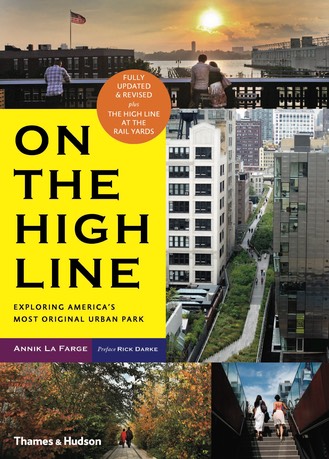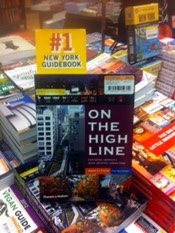On sale now, a fully revised, updated edition of ON THE HIGH LINE!

NEW MATERIAL INCLUDES:
● The High Line at the Rail Yards: key features in section 3, including the Catwalk, kids play area, Rail Walk, and more;
● The Interim Walkway: a path that winds through the still-wild garden and wraps around the West Side Rail Yards;
● Architecture around the rail yards and more stories about trains on the west side of Manhattan;
● An elegant meditation by Rick Darke on the High Line as “this city’s greatest runway through time";
● An introduction to the folks at Friends of the High Line, the group that saved, built, and runs the park;
● Designing the High Line: an essay about the design philosophy and the team that created the High Line;
● Dozens of updates, revisions and new entries, plus more than 75 new photographs and a new map
On the High Line was originally published in May 2012 and covered the first two sections of the park: Gansevoort to 20th Street (opened June 9, 2009) and 20th to 30th Streets, (opened June 8, 2011). A key theme of the first edition was change: how the area around the High Line shifted from a 19th century industrial powerhouse with freight trains running up and down the avenue (see rare archival footage here) to a multi-zoned, dynamic 21st century place that has more art galleries per square foot than any other neighborhood in the world. It described how the linear park has attracted some of the most interesting new architecture in Manhattan, and how it became a magnet for the tech, food, art and fashion industries.
The revised & updated edition of On the High Line is a product of even more change. One piece, “Automobile Row," had to be deleted altogether. It reported on the “high ratio of automobiles to humans” and the car-centric character of West Chelsea, which made it a particularly easy place to park, repair, gas up, wash, or purchase a luxury car. Commercial and residential development are rapidly re-writing the local landscape, and since the first edition came out most of the old car shops and garages are gone. In one of the most telling examples of change, a gas station adjacent to the High Line recently became an outdoor art gallery. (Read more and see photographs here.)
The new edition records dozens of changes, from the closing of a women’s prison on 20th Street in the wake of Hurricane Sandy to the ground-breaking of the first major urban greenway project to be inspired by the High Line: Chicago’s 606, a linear park built on the former elevated Bloomingdale line.
But most important are the additions, which provide a much a richer picture of the High Line today. New material includes:
- The High Line at the Rail Yards. 16 pages on the highly anticipated Section Three, which will have a truly transformative effect on the park. This new chapter offers commentary, history and photography to deepen a visitor’s understanding of the many elements and features of this new section.
- The Spring Cutback. A two-page spread about the annual, volunteer-powered six-week project to cut back the park’s more than 100,000 plants and grasses. This piece gives a reader insight into the design philosophy behind the High Line’s gardens, and the unique way in which they are maintained.
- Designing the High Line. How the park was conceived and built; the ideas that are embedded in its design and landscape architecture; and the people who created it.
- Friends of the High Line. This essay about the group that saved, built and runs the park provides a window into the values and priorities that drive this extraordinary organization, and shows how its employees and volunteers help define the experience of the High Line, both for the park’s local community and the millions of visitors who come from near and far.
- The Time Line. An elegant meditation by landscape ethicist and writer Rick Darke on the High Line as “this city's greatest runway through time.”
- High Line Food. How food has become an essential part of the park experience, from the many vendors operating from carts within the park to a new restaurant in a glass box underneath it on Washington Street.
- Architecture around section three, including the fascinating and odd-looking Westyard Distribution Center, which sits atop a complex intersection of train networks in Manhattan.
- A new map, specially created for the 2nd edition by Maps for Good co-founder Marty Schnure, illustrates how the High Line roughly follows the pre-landfill, original shoreline of Manhattan and includes the location of a 17th century Lenape trail.
- More than 75 new photographs, including archival, contemporary, and aerial shots of the park and its surrounding architecture.
On the High Line: Exploring America’s Most Original Urban Park, Revised & Updated
Published by Thames & Hudson, May 13, 2014


